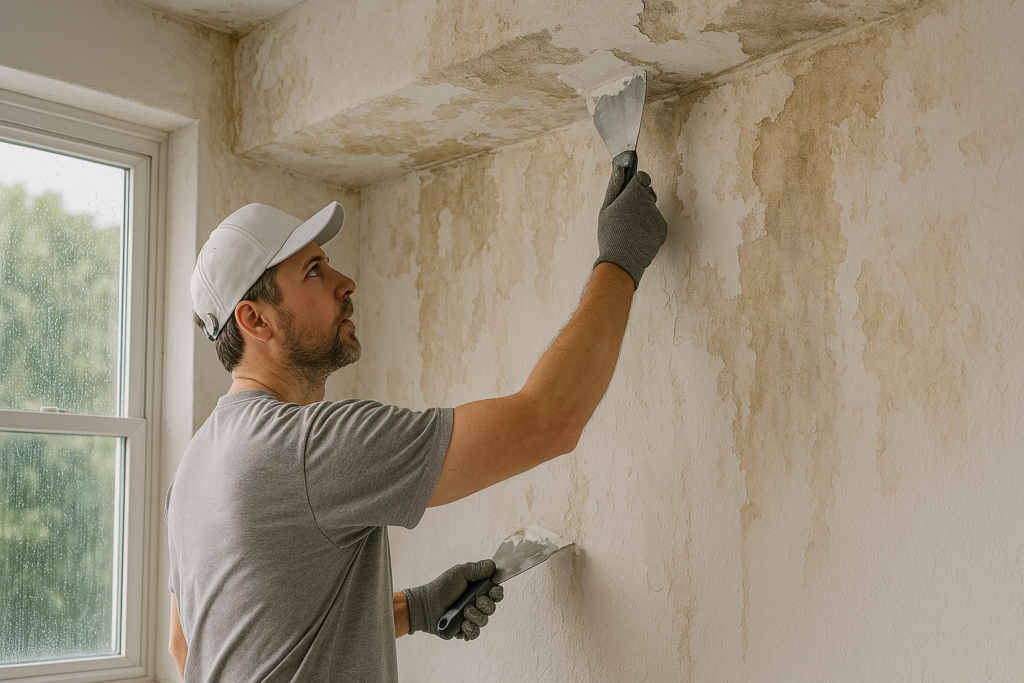Water damage in your home is more than just a temporary inconvenience; it can set the stage for serious problems, including mold growth. Mold thrives in damp, dark environments, making water damage an ideal condition for its development. Understanding how water damage can lead to mold and knowing what steps to take to address it is essential for maintaining a healthy and safe living environment. In this article, we will explore the relationship between water damage and mold growth and provide practical advice on how to manage and prevent mold issues.
How Water Damage Leads to Mold Growth
Moisture as a Mold Catalyst
Mold requires moisture to grow, and water damage provides the perfect environment for mold spores to settle and flourish. Whether it’s from a burst pipe, a leaking roof, or an overflowing sink, any source of water that introduces excess moisture into your home can lead to mold growth. Mold spores are always present in the environment, but they only begin to grow when they find the right conditions, including a moist surface. Once water damage occurs, these spores can start colonizing and multiplying, leading to a mold infestation.
Infiltration and Accumulation of Water
Water damage can infiltrate various building materials, such as drywall, wood, and insulation. When these materials become saturated, they provide an ideal environment for mold growth. For example, water from a leaking roof can seep into the attic, causing moisture to accumulate in insulation and wooden beams. Similarly, water from a broken pipe can saturate drywall and wooden floors. This moisture creates a breeding ground for mold, which can then spread throughout the affected areas.
Hidden Mold Growth
One of the dangers of water damage is that it can cause mold to grow in hidden or hard-to-reach areas. Mold can thrive behind walls, under floors, and in other concealed spaces where water damage may not be immediately visible. For instance, a slow leak in a pipe can lead to mold growth inside wall cavities or beneath flooring. Because these areas are not easily accessible, mold can continue to grow unchecked and cause more extensive damage before it is discovered.
Extended Exposure to Moisture
If water damage is not addressed quickly, the prolonged exposure to moisture increases the risk of mold growth. Mold can start to develop within 24-48 hours of water damage if the area remains wet. The longer water is allowed to sit, the more extensive the mold growth can become. Therefore, it’s crucial to address water damage as soon as it occurs to prevent mold from taking hold.
Steps to Take After Water Damage to Prevent Mold Growth
Address the Water Source
The first and most important step in preventing mold growth is to fix the source of the water damage. Whether it’s repairing a leaky roof, fixing a broken pipe, or unclogging a drain, addressing the root cause of the water damage stops further moisture from entering the area. Without resolving the source of the water, any efforts to remove mold will be ineffective, as the ongoing moisture will continue to foster mold growth.
Remove Standing Water
After fixing the source of the water damage, the next step is to remove any standing water. Use a wet/dry vacuum to extract water from floors and other surfaces. For larger amounts of standing water, you might need to use a pump or call a professional water damage restoration service. Prompt removal of standing water is crucial to prevent mold from starting to grow.
Dry Out the Affected Areas
Thorough drying is essential to prevent mold growth. Use fans, dehumidifiers, and open windows to increase airflow and reduce humidity in the affected area. If the water damage is extensive, you may need to use industrial-grade dehumidifiers and air movers. Ensuring that the area is completely dry within 24-48 hours is crucial for preventing mold growth.
Clean and Disinfect the Area
Once the area is dry, clean and disinfect all surfaces that were affected by water damage. Use a mixture of water and detergent to clean surfaces, and consider using an antimicrobial solution to kill any remaining mold spores. Be sure to follow safety precautions, such as wearing gloves and a mask, to avoid exposure to mold spores.
Inspect for Hidden Mold
After the visible water damage has been addressed, inspect for hidden mold in areas like behind walls, under floors, and in the attic. Use a moisture meter to check for damp areas and look for signs of mold growth. If you suspect hidden mold but cannot access these areas yourself, it may be necessary to hire a professional mold inspector.
Replace Damaged Materials
Some materials affected by water damage, such as drywall, insulation, or carpet, may be too damaged to clean effectively. In these cases, it’s best to remove and replace the damaged materials. Moldy materials should be disposed of properly in sealed plastic bags to prevent the spread of mold spores.
Repair and Restore
After removing damaged materials and ensuring that the area is dry, you can begin the repair and restoration process. This may include replacing drywall, repairing leaks, and repainting surfaces. Be sure to use mold-resistant materials where possible to help prevent future mold issues.
Monitor and Maintain
Ongoing monitoring and maintenance are essential for preventing future water damage and mold growth. Regularly inspect your home for signs of leaks or moisture issues, and ensure that your home’s drainage system is functioning properly. Installing and maintaining a dehumidifier can also help keep indoor humidity levels within the recommended range to prevent mold growth.
When to Seek Professional Help
While some minor water damage and mold issues can be managed by homeowners, there are situations where professional help is necessary. If you have extensive water damage, a large mold infestation, or hidden mold that you cannot access, it’s best to call a professional water damage restoration and mold remediation service. Professionals have the expertise, equipment, and techniques to handle complex mold problems and ensure that your home is properly restored.
Conclusion
Water damage can lead to serious problems, including mold growth, which poses significant health risks and can cause extensive structural damage. Understanding how water damage facilitates mold growth and knowing the steps to take can help you manage and prevent mold issues effectively. By addressing the source of water damage, removing moisture, cleaning and disinfecting affected areas, and monitoring for future problems, you can protect your home and your health from the dangers of mold.

